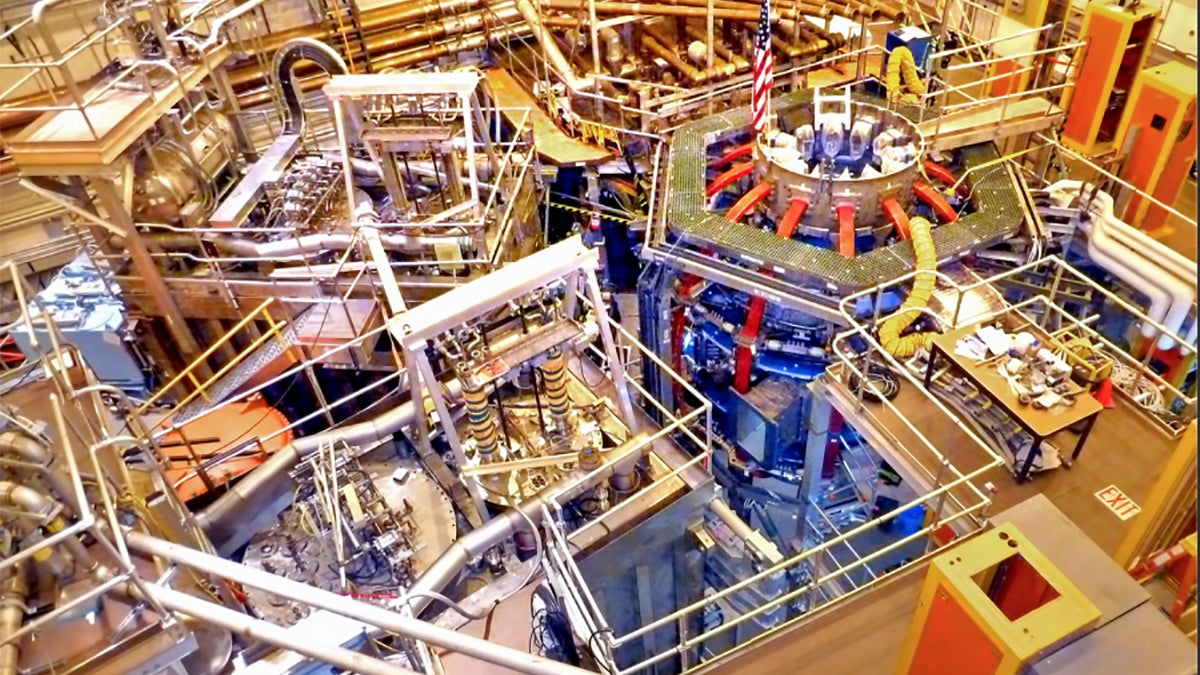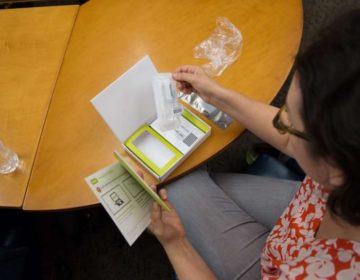Princeton Plasma Physics Laboratory’s $94 M upgrade to world’s most powerful fusion experiment
Listen
NSTX-U facility (Elle Starkman/PPPL Office of Communications)
The Princeton Plasma Physics Laboratory (PPPL) just celebrated a milestone in its research on fusion energy. After nearly four years of round-the-clock work by 250 people, the PPPL completed a $94 million upgrade to its flagship fusion facility, the National Spherical Torus Experiment (NSTX-U).
Department of Energy Secretary Ernest Moniz donned a white hard hat to tour the NSTX-U’s test cell facility and the 85-ton machine at the center.
The NSTX-U is a fusion energy experiment contained in a spherical tokamak reactor. This design is an apple-core shape that requires less energy than traditional tokamaks, which are bulkier (and often more expensive to operate).
Like the sun, the NSTX-U is powered by fusion. Though the sun uses the weight of gravity to confine and “fuse” atomic nuclei together, NSTX-U uses a powerful magnetic field to “confine” super-hot plasma to produce fusion reactions. This magnetic fusion, in turn, generates energy.
While the energy produced by the sun’s fusion is light and heat, the energy generated by the NSTX-U is in the form of neutrons, not light. The NSTX-U is a bit like a “dark star”, with a power density 100,000 greater than the sun.
The $94 million upgrade added a stack of 36 350-lb copper conductors, each 20 feet long. Together, these can produce a magnetic field of 1 tesla, which is 20,000 times stronger than the Earth’s. The upgrade also added a second neutral beam box, which is a device that injects a 2,000-amp current into the plasma. (Plasma is a fourth type of matter; it’s created by heating gas at high temperatures. In the NSTX-U, the plasma is at a temperature of 100 million degrees.) The new neutral beam box’s current is strong enough to power two million 100-watt light bulbs.
The PPPL’s upgrade enables the facility to operate under conditions that more closely resemble what a potential fusion power plant could look like someday.
Secretary Moniz dedicated the NSTX-U, which is now the most powerful fusion device of its kind in the world. Unveiling a plaque in the main NSTX-U “Command Center” control room, Secretary Moniz said he believes fusion energy should be a key part of the country’s potential for securing a future with safe, reliable, and “clean” energy.
“We at the Department of Energy have a clear philosophy,” he said. “We must support, across the board, the portfolio of technologies that can lead us to deep electricity de-carbonization,” he said.
According to the the U.S. Energy Information Administration, more than 60 percent of the electricity generated in the U.S. comes from coal and natural gas. The Princeton Plasma Physics Laboratory’s NSTX-U research could someday lead to a workable fusion power plant — potentially reducing carbon emissions and reliance on fossil fuels.
Moniz stated that fusion energy is particularly well-suited to meet the nation’s electricity needs, and suggested that the technology might someday earn its place as a potential energy source in the nation’s “low-carbon portfolio.” He emphasized his belief in the importance of pursuing energy solutions in the context of a “high-risk, high-reward” marketplace, with an eye towards innovation.
“Some of those technologies (sometimes with policy assistance) are about immediate deployment,” Secretary Moniz said. They can help the country meet certain clean energy goals by 2025. But other developments, “like what is happening here, are clearly working in a longer time frame, but with the potential for enormous rewards.”
Moniz reflected on the Obama administration’s commitments to lowering carbon emissions, and his participation in the 2015 Paris Climate Change talks.
He said the Paris talks were a good “first step” in the quest for clean energy. Moniz says he’s seeking to double the U.S. energy technology innovation budget over five years.
The PPPL’s $94 million upgrade doubled the strength of the device’s magnetic field, plasma current, and heating power. It also quadrupled the length of potential fusion experiments (plasma “shots”) — a perk that will surely make the lives of NSTX-U’s researchers a bit easier.
One of the PPPL’s staff research physicists is Francesca Poli, who spent years simulating and designing potential plasma experiments — over 4,000 experiments in all.
“For me, now the exciting part is to see these experiments. And to see whether what we have predicted actually works or not,” she said.
Poli and other researchers now can conduct 30 experiments per day.
WHYY is your source for fact-based, in-depth journalism and information. As a nonprofit organization, we rely on financial support from readers like you. Please give today.





